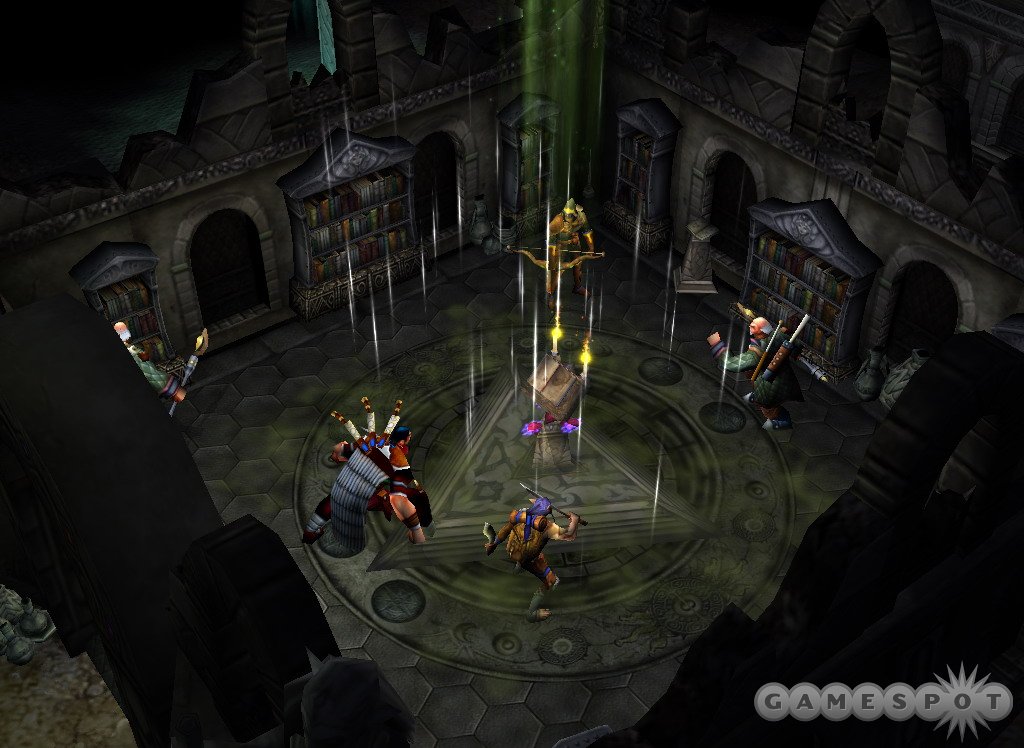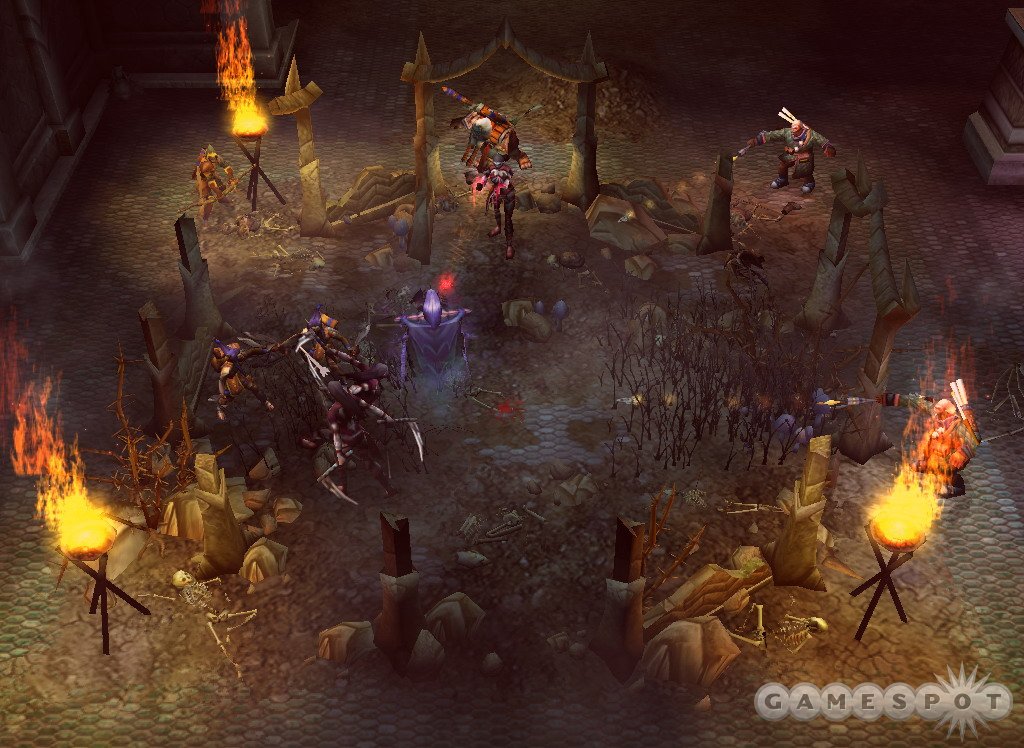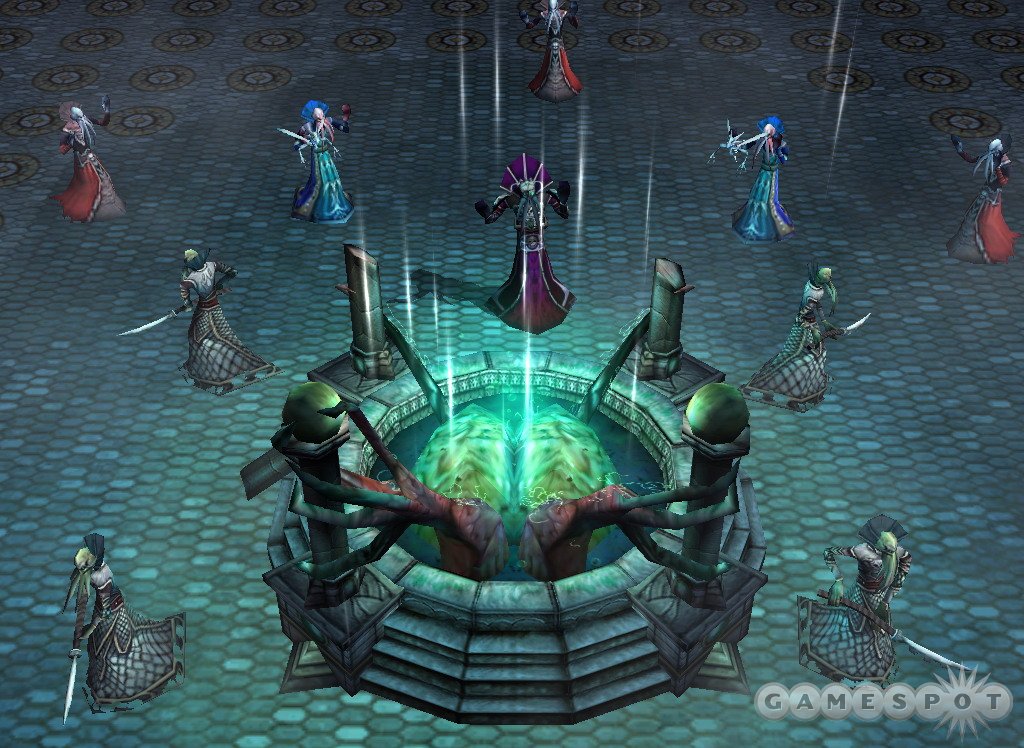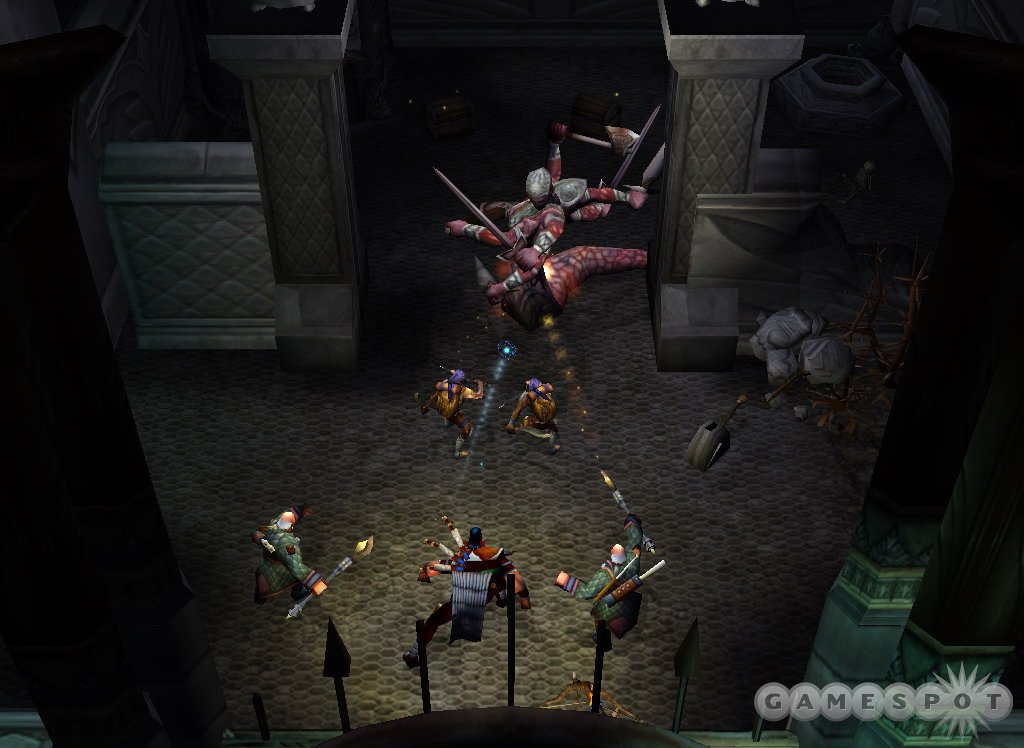Dragonshard Designer Diary #3 - Monsters and Rewards
Designer Charley Price discusses some of the terrifying monsters and opponents you'll battle in this next-generation real-time strategy game.
Dragonshard is an upcoming real-time strategy game with a bit of a split personality. This fantasy-based game, whose roots lie in the Dungeons & Dragon's Eberron campaign setting, will not only feature above- and below-ground action at the same time, but also will look to combine the epic feeling of real-time strategy with traditional role-playing adventure. The result will not be your typical real-time strategy game, as the developers are looking to get away from the traditional resource-gathering, base-building, and tank-rushing that is commonplace in RTS games. In this new edition of our designer diaries, one of the game's designers explains how the monsters you'll battle will differ from those of other RTS games.
Risk and Reward
by Charley Price
Designer, Liquid Entertainment
In order for the dual-layer system in Dragonshard to be as robust as possible, we knew we needed to ensure that each layer presented a distinct yet familiar gameplay experience. To do so, we went to great lengths to ensure that the above-ground gameplay provided the player with a unique and dynamic large-scale real-time-strategy experience by means of squads, captains, soldiers, and other gameplay innovations (as discussed in earlier diaries). The underworld, on the other hand, was an entirely different story. It was here that we hoped to re-create the atmosphere and gameplay dynamics that were so familiar to us from Dungeons & Dragons. In doing so, not only have we implemented a wide array of tombs, shrines, and temples scattered throughout the ancient sunken city that encompasses our underworld, but also we have packed it with gold, treasure, traps, and, of course, monsters.

One of the challenges that we faced in developing a Dungeons & Dragons RTS was determining how to incorporate and, oftentimes, interpret monsters in the context of our game while still retaining their distinct, iconic D&D feel. In doing so, we are planning to implement a number of unique and interesting systems that not only allow for more-advanced behavior than is found in many RTS games, but also successfully re-create the different types of encounters a D&D party faces when it engages each particular type of monster. Unlike some games, which have a vast array of different-looking monsters that essentially do the same thing (attack, be attacked, and die), D&D encounters are inherently unique and dynamic depending on the makeup of your party and the abilities and tactics of your opponents. In fact, much of what makes encounters in D&D so fun is the opportunity for you to use your preexisting knowledge of the strengths, weaknesses, and abilities of both your allies and the creatures you encounter. Facing off against a winter wolf and a gelatinous cube will each demand tactics unique to that situation, and we want to provide you with the opportunity to discover and execute those strategies as you play. Similarly, for players who are already acquainted with D&D, we want our monsters to be immediately familiar and recognizable, not only in terms of appearance, but also in terms of behavior.

For example, we have illithids (mind flayers) as one of the many monster races in Dragonshard. While there are illithid fighters and illithid wizards, each with different tactics and abilities, they both share two iconic abilities that are no doubt familiar to anyone who has ever encountered these foes in their D&D campaigns. The first is mind blast, a psionic ability that serves as a ranged stun attack, dazing the targeted unit for a particular period of time. The second is brain extraction, a damage-over-time ability with instant kill potential. When a mind flayer approaches a dazed target, it can attempt to extract its brain, provided the dazed target has one (war-forged units, for example, are immune). This locks the mind flayer into a brain-extraction stance as it latches its tentacles on to the skull of its prey and begins to gnaw its way into the cranial cavity. Throughout this process, the victim is slowly taking damage, which, while notable, is not nearly as lethal as, say, a scorpion's venom. However, if the mind flayer remains attached long enough, it will successfully bore through flesh and bone and gleefully wrench its victim's brain into its gaping maw, killing the unit instantly.
When Driders Attack
While these two illithid abilities are certainly lethal (especially when used in conjunction with each other), there are tactics that can be used to defeat such foes. Using one unit as a "mule" to go in and absorb all the initial mind blasts can be key to making mind flayers safe to engage (at least until they can mind blast again). Similarly, using buffs to increase resistances can prevent the mind blast from working at all, rendering your units immune to that series of attacks altogether. However, even if you do haphazardly stumble upon an unholy gathering of these creatures unprepared, there are still other ways out. While extracting a target's brain, a mind flayer is immobile, and any damage it receives will interrupt it and return its target back to fighting condition.

In multiplayer, mind flayer and monster interaction can be taken to a whole new level. In one of our maps, deep beneath the ground, at the core of a half-submerged illithid citadel, lies an elder brain. This primordial pool is where all the brain matter from fallen mind flayers is placed, where it serves as a psionic hub of sorts for all illthids in the area. If a party were able to defeat the illithids defending this unholy site, it might be able to wrench away command of all illithids that remain on the map. The party could then send them to war against opposing armies...that is, unless said armies were able to seize the elder brain away from the party.
In contrast to the illithids, which are often encountered in small, balanced groups, we also have a wide array of giant, screen-filling, badass boss monsters that are able to take on entire armies single-handedly. A prime example of one of these creatures is the drider. Half cursed elf and half monstrous spider, driders are classic creatures from D&D lore. In Dragonshard, the drider represents just one of the many monsters that can turn the tide against wave after wave of oncoming foes.
First among the drider's many feats is the ability to multi-attack, an ability also shared by the ettin, the marilith, and others. The drider can attack using her clawed hands, spells, and mandibles, which allow her to dynamically target multiple assailants within melee range. As such, she actually reaches her maximum-damage-output potential when she has many units engaged in close quarters. However, that is not all that she can do. She also has the ability to cocoon targets, encasing them in thick, rapidly hardening webbing that's coated with toxic venom. If an allied unit does not hack its comrade free in great haste, not only does the victim perish, but also the victim becomes a nourishing meal for one of the drider's eggs. As soon as the unit dies, the cocoon collapses into a foul, pulsing egg sac that, unless directly attacked, will soon erupt, revealing a vicious, venomous spider in its place. In addition to these already potent abilities, the drider is able to web units either in front or behind her, effectively rooting them in place. Furthermore, the drider can leap from battle when gravely injured and then scuttle across the walls and ceiling, far out of reach, as her vile spawn assail her opponents. She'll then drop back into the fray once more to knock targets off their feet.
Thus, as you can see, the drider is more than capable of handling large numbers of units alone. Granted, there are, of course, many tactics that are successful against her, but discovering these tactics and executing them on the fly represents one of the many moments that our players cite as "feeling just like D&D."

Considering that these formidable monsters possess all these nasty abilities, you may wonder why you would even bother fighting these crazy things? Well, in addition to the substantial gold and experience you can acquire, there are also little things like "a horn of devil calling," which can summon a horned devil from the pits of Baator to your aid. You can also, perhaps, acquire a crystalline war hammer, which encases its target in ice with every strike, slowing its move and attack speeds. There's also the terrifying vorpal blade, a fearsome weapon that can instantly slay opposing units, causing them to erupt in explosions of flesh and blood. Needless to say, we want to reward the player as much as we want to challenge him or her. With all that said, we feel that if, after delving deep into the underworld, engaging in harrowing battles with any number of foul beasts, and rejoicing over the spoils, you lean back and grin...then we have done our job.
Got a news tip or want to contact us directly? Email news@gamespot.com
Join the conversation